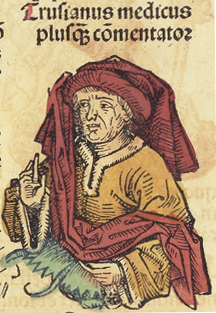|
Turisanus
Turisanus de Turisanis was the Latin name of Pietro Torrigiano de' Torrigiani (died c. 1320), a theoretical physician from a well-known Florentine family who taught medicine in Paris, c. 1305–19, and wrote an elaborated and influential series of commentaries on Galen's ''Microtechni'', ''Plusquam commentum in Microtechni Galenii'' and a shorter ''De hypostasi urine Galeni''. The two commentaries, all that survives of Torrigiani's output, were printed together by Ugo Rugerius in 1489, and in several later editions, both incunabula and 16th-century printings. The work took the conventional form of the set of '' quaestiones disputatae'' familiar in Scholasticism. He was trained in the famed medical school of Bologna as a pupil of the Florentine Taddeo Alderotti (Thaddeus Florentinus). In his old age he retired to a Carthusian monastery This is a list of Carthusian monasteries, or charterhouses, containing both extant and dissolved monasteries of the Carthusians (also known as ... [...More Info...] [...Related Items...] OR: [Wikipedia] [Google] [Baidu] |
Taddeo Alderotti
Taddeo Alderotti (Latin: Thaddaeus Alderottus, French : Thaddée de Florence), born in Florence between 1206 and 1215, died in 1295, was an Italian doctor and professor of medicine at the University of Bologna, who made important contributions to the renaissance of learned medicine in Europe during the High Middle Ages. He was among the first to organize a medical lecture at the university. One of his works describes a method for concentrating ethanol involving repeated fractional distillation through a water-cooled still, by which an ethanol purity of 90% could be obtained. Dante seems to reference him in the Paradiso (XII, 82-85), indicating he pursued learning not for spiritual reasons but worldly ambition, contrasting him with St. Dominic. Life Taddeo Alderotti was born in Florence, 1210, and received his primary education there.Thomas F. Glick, Steven Livesey, and Faith Wallis, ''Medieval Science, Technology, and Medicine: An Encyclopedia'' (Routledge, 2014) In the m ... [...More Info...] [...Related Items...] OR: [Wikipedia] [Google] [Baidu] |
Nuremberg Chronicle F 222v 2
Nuremberg ( ; german: link=no, Nürnberg ; in the local East Franconian dialect: ''Nämberch'' ) is the second-largest city of the German state of Bavaria after its capital Munich, and its 518,370 (2019) inhabitants make it the 14th-largest city in Germany. On the Pegnitz River (from its confluence with the Rednitz in Fürth onwards: Regnitz, a tributary of the River Main) and the Rhine–Main–Danube Canal, it lies in the Bavarian administrative region of Middle Franconia, and is the largest city and the unofficial capital of Franconia. Nuremberg forms with the neighbouring cities of Fürth, Erlangen and Schwabach a continuous conurbation with a total population of 800,376 (2019), which is the heart of the urban area region with around 1.4 million inhabitants, while the larger Nuremberg Metropolitan Region has approximately 3.6 million inhabitants. The city lies about north of Munich. It is the largest city in the East Franconian dialect area (colloquially: "Franconian"; ... [...More Info...] [...Related Items...] OR: [Wikipedia] [Google] [Baidu] |

